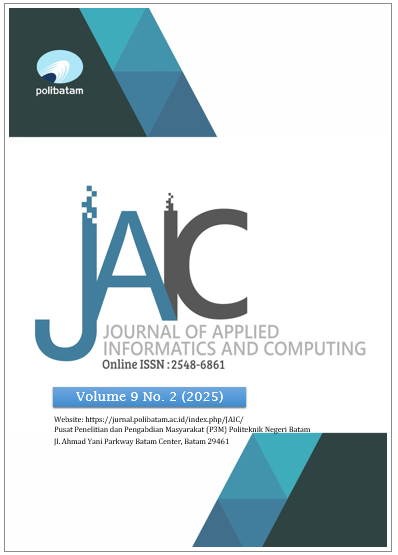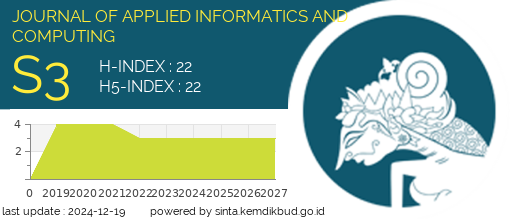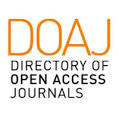Sentiment Analysis for the 2024 DKI Jakarta Gubernatorial Election Using a Support Vector Machine Approach
DOI:
https://doi.org/10.30871/jaic.v9i2.9260Keywords:
Public Sentiment, Support Vector Machine, Gubernatorial Election 2024, DKI Jakarta, TwitterAbstract
This study analyzes public sentiment regarding candidates in the 2024 DKI Jakarta Gubernatorial Election utilizing a Support Vector Machine (SVM) approach. Recognizing the pivotal role of social media, particularly Twitter, in shaping public opinion, the research addresses the challenges of processing large volumes of unstructured data. Through systematic data preprocessing and feature extraction, the SVM model was applied, achieving a sentiment classification accuracy of 70%. The analysis revealed a distribution of sentiments where 36.1% of comments were positive, 33.4% negative, and 30.5% neutral. These findings illustrate the complexities of public discourse surrounding key political events, highlighting the model's efficacy and the nuances of sentiment detection. Moreover, discussions on model limitations elucidate areas for enhancement, suggesting future avenues including the adoption of more sophisticated algorithms and improved data processing techniques. This research contributes to the understanding of voter sentiment dynamics in a significant electoral context, providing insights that may assist campaign strategies and political analyses in Indonesia.
Downloads
References
[1] M. A. Putra Hidayat, “Gaya Kepemimpinan Basuki Tjahaja Purnama Saat Menjadi Gubernur Dki Jakarta,” UIN HIdayatullah Jakarta, Jun. 2022, [Online]. Available: https://www.researchgate.net/publication/361421421
[2] A. N. Izzati, “Analisis Sentimen Hasil Putusan Mk Terkait Sengketa Pilpres 2024 Pada Media Sosial X,” Jurnal Teknologi Informasi Indonesia (JTII), vol. 9, no. 1, pp. 43–50, 2024, doi: 10.30869/jtii.v9i1.1338.
[3] K. Rahayu, V. Fitria, D. Septhya, R. Rahmaddeni, and L. Efrizoni, “Klasifikasi Teks untuk Mendeteksi Depresi dan Kecemasan pada Pengguna Twitter Berbasis Machine Learning,” MALCOM: Indonesian Journal of Machine Learning and Computer Science, vol. 3, no. 2, pp. 108–114, Sep. 2023, doi: 10.57152/malcom.v3i2.780.
[4] Ade Dwi Dayani, Yuhandri, and G. Widi Nurcahyo, “Analisis Sentimen Terhadap Opini Publik pada Sosial Media Twitter Menggunakan Metode Support Vector Machine,” Jurnal KomtekInfo, pp. 1–10, 2024, doi: 10.35134/komtekinfo.v11i1.439.
[5] Faruqi, Z. El, D. E. Ratnawati, and R. S. Perdana, “Analisis Sentimen Pendapat Masyarakat Mengenai Pemilu 2024 Pada Platform Twitter/X Menggunakan Metode Support Vector Machine (SVM),” Thesis (Sarjana), Universitas Brawijaya, 2024.
[6] E. P. Nuansa, “Analisis Sentimen Pengguna Twitter Terhadap Pemilihan Gubernur DKI Jakarta Dengan Metode Naive Bayesian Classification dan Support Vector Machine,” Tugas Akhir, Institut Teknologi Sepuluh Nopember (ITSN), Surabaya, 2017.
[7] J. Anggraini and D. Alita, “Implementasi Metode SVM Pada Sentimen Analisis Terhadap Pemilihan Presiden (Pilpres) 2024 Di Twitter,” Jurnal Informatika, vol. 9, no. 2, pp. 102–111, 2024, doi: 10.30591/jpit.v9i2.6560.
[8] R. Deswandi Yahya, S. Adi Wibowo, and N. Vendyansyah, “Analisis Sentimen Untuk Deteksi Ujaran Kebencian Pada Media Sosial Terkait Pemilu 2024 Menggunakan Metode Support Vector Machine,” JATI (Jurnal Mahasiswa Teknik Informatika), vol. 8, no. 2, pp. 1182–1189, 2024, doi: 10.36040/jati.v8i2.9076.
[9] J. Anggraini and D. Alita, “Implementasi Metode SVM Pada Sentimen Analisis Terhadap Pemilihan Presiden (Pilpres) 2024 Di Twitter,” Jurnal Informatika: Jurnal Pengembangan IT, vol. 9, no. 2, pp. 102–111, 2024, doi: 10.30591/jpit.v9i2.6560.
[10] Z. Purwanti, “Pemodelan Text Mining untuk Analisis Sentimen Terhadap Program Makan Siang Gratis di Media Sosial X Menggunakan Algoritma Support Vector Machine ( SVM ),” vol. 5, no. 3, pp. 3065–3079, 2024.
[11] A. K. Sari, A. Irsyad, and D. N. Aini, “Analisis Sentimen Twitter Menggunakan Machine Learning untuk Identifikasi Konten Negatif,” vol. 3, no. 1, pp. 64–73, 2024.
[12] A. Sentimen, “Perbandingan Pelabelan Data dalam Analisis Sentimen Kurikulum Proyek di platform TikTok : Pendekatan Naïve Bayes,” pp. 96–107, 2024, doi: 10.30864/eksplora.v14i1.1093.
[13] D. P. . Yuwono, I. B. . Santoso, and R. Kusumawati, “Pemetaan Sentimen Masyarakat Terhadap Pilpres 2024 Dengan Algoritma Self-Organizing Map”, JRPP, vol. 7, no. 3, pp. 7518–7523, Jun. 2024.
[14] W. Ningsih, B. Alfianda, and D. Wulandari, “Comparison of Naive Bayes and SVM Algorithms in Twitter Sentiment Analysis on Electric Car Use in Indonesia Perbandingan Algoritma SVM dan Naïve Bayes dalam Analisis Sentimen Twitter pada Penggunaan Mobil Listrik di Indonesia,” vol. 4, no. April, pp. 556–562, 2024.
[15] A. M. Yolanda and R. T. Mulya, “Implementasi Metode Support Vector Machine untuk Analisis Sentimen pada Ulasan Aplikasi Sayurbox di Google Play Store,” vol. 6, no. 2, pp. 76–83, 2024, doi: 10.35580/variansiunm258.
[16] A. A. Pratiwi and M. Kamayani, “Perbandingan Pelabelan Data dalam Analisis Sentimen Kurikulum Proyek di platform TikTok : Pendekatan Naïve Bayes,” Jurnal Eksplora Informatika, vol. 14, no. 1, pp. 96–107, 2024, doi: 10.30864/eksplora.v14i1.1093.
[17] N. Putri, D. S. Angreni, and I. W. Sudarsana, “A Study on Sentiment Analysis of Public Response to the New Fuel Price Policy in 2022: A Support Vector Machine Approach,” IJCDCG3, 2023.
Downloads
Published
How to Cite
Issue
Section
License
Copyright (c) 2025 Mariani, Dwi Shinta Angreni, Sri Khaerawati Nur , Rinianty, Deni Luvi Jayanto

This work is licensed under a Creative Commons Attribution-ShareAlike 4.0 International License.
Authors who publish with this journal agree to the following terms:
- Authors retain copyright and grant the journal right of first publication with the work simultaneously licensed under a Creative Commons Attribution License (Attribution-ShareAlike 4.0 International (CC BY-SA 4.0) ) that allows others to share the work with an acknowledgement of the work's authorship and initial publication in this journal.
- Authors are able to enter into separate, additional contractual arrangements for the non-exclusive distribution of the journal's published version of the work (e.g., post it to an institutional repository or publish it in a book), with an acknowledgement of its initial publication in this journal.
- Authors are permitted and encouraged to post their work online (e.g., in institutional repositories or on their website) prior to and during the submission process, as it can lead to productive exchanges, as well as earlier and greater citation of published work (See The Effect of Open Access).











